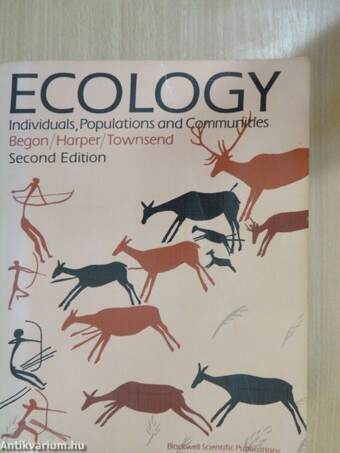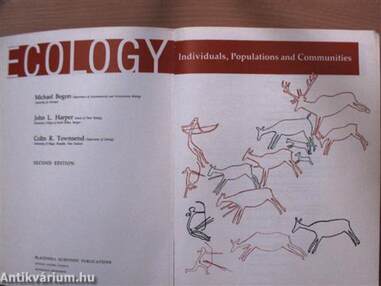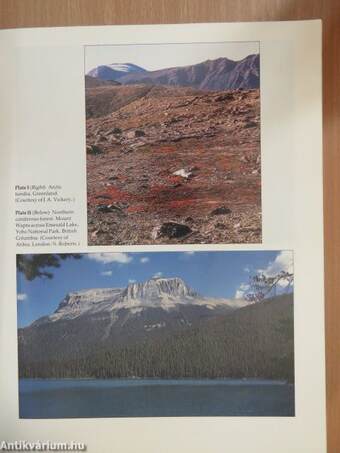1.060.331
kiadvánnyal nyújtjuk Magyarország legnagyobb antikvár könyv-kínálatát

VISSZA
A TETEJÉRE
JAVASLATOKÉszre-
vételek
Ecology
Individuals, Populations and Communities
| Kiadó: | Blackwell Scientific Publications |
|---|---|
| Kiadás helye: | Boston |
| Kiadás éve: | |
| Kötés típusa: | Ragasztott papírkötés |
| Oldalszám: | 945 oldal |
| Sorozatcím: | |
| Kötetszám: | |
| Nyelv: | Angol |
| Méret: | 25 cm x 20 cm |
| ISBN: | 0-632-02344-9 |
| Megjegyzés: | Fekete-fehér fotókkal, ábrákkal és néhány színes fotóval. |
naponta értesítjük a beérkező friss
kiadványokról
naponta értesítjük a beérkező friss
kiadványokról
Előszó
As the cave painting on the front cover of this book implies, ecology, if not the
oldest profession, is probably the oldest science. Soon after our primitive an-
cestors had their first... Tovább
Előszó
As the cave painting on the front cover of this book implies, ecology, if not the
oldest profession, is probably the oldest science. Soon after our primitive an-
cestors had their first conscious thoughts, they must have realized the value of
knowing where they might find palatable plants and catchable animals, and
where they might be safe from the enemies that sought to attack them. Today,
however, we can go much further than this. We know that if we are to make
use of the products of the natural world without destroying them, if we are to
produce food for ourselves rather than for our pests, and if we are to predict
what happens next' in our environments, then we must understand the
natural world and the organisms that comprise it. This, then, is a book
designed to document and promote such understanding. It is a book about the
distribution and abundance of different types of organism over the face of the
Earth, and about the physical, chemical but especially the biological features
and interactions that determine these distributions and abundances.
Unlike some other sciences, the subject matter of ecology is apparent to
everybody; to the extent that most people have observed and pondered nature,
most people are ecologists of sorts. But ecology is not an easy science, and it
has particular subtlety and complexity. It must deal explicitly with three levels
of the biological hierarchy — the organisms, the populations of organisms,
and the communities of populations — and, as we shall see, it ignores at its
peril the details of the biology of individuals, or the pervading influences of
historical, evolutionary and geological events. It feeds, in a peripheral way, on
advances in our knowledge of biochemistry, behaviour, climatology, plate
tectonics and so on, but it feeds back to our understanding of vast areas of
biology too. If, as T.H. Dobzhansky said, 'Nothing in biology makes sense,
except in the light of evolution', then, equally, very little in evolution makes
sense, except in the light of ecology —that is, in terms of the interactions
between organisms and their physical, chemical and biological environments.
Ecology also has the distinction of being peculiarly confronted with
uniqueness: millions of different species, countless billions of genetically dis-
tinct individuals, all living and interacting in a varied and ever-changing
world. The beauty of ecology is that it challenges us to develop an under-
standing of very basic and apparent problems, in a way that recognizes the
uniqueness and complexity of all aspects of nature but seeks patterns and
predictions within this complexity rather than being swamped by it. As L.C.
Birch has pointed out, the physicist Whitehead's recipe for science is never
more apposite than when applied to ecology: seek simplicity, but distrust it.
In this book, we have aimed to build an understanding by moving from
organisms to populations to communities. But sometimes, and especially in
vii PREFACE Vissza
Fülszöveg
ECOLOGY
The first edition of this successful textbook was
praised for its breadth of coverage and
freshness of approach. In its new edition,
Ecology is completely revised and thoroughly
updated, with almost 300 new references, and
retains the overall philosophy which has proved
so popular As before, the study of plant and
animal ecology is fully integrated, and
mathematical and laboratory studies are
described where necessary. However, examples
drawn from real ecological systems illustrate
both the complexity of the subject, and the way
diverse areas such as descriptive natural history,
environmental physiology, behaviour, field
experimentation and mathematical modelling
can be brought together to solve ecological
problems. The authors attempt, throughout, to
encourage the reader to combine all of the
above facets of ecology so that wherever his or
her strengths lie — in the field or laboratory, in
theory or in practice — a balanced and up-to-
date view... Tovább
Fülszöveg
ECOLOGY
The first edition of this successful textbook was
praised for its breadth of coverage and
freshness of approach. In its new edition,
Ecology is completely revised and thoroughly
updated, with almost 300 new references, and
retains the overall philosophy which has proved
so popular As before, the study of plant and
animal ecology is fully integrated, and
mathematical and laboratory studies are
described where necessary. However, examples
drawn from real ecological systems illustrate
both the complexity of the subject, and the way
diverse areas such as descriptive natural history,
environmental physiology, behaviour, field
experimentation and mathematical modelling
can be brought together to solve ecological
problems. The authors attempt, throughout, to
encourage the reader to combine all of the
above facets of ecology so that wherever his or
her strengths lie — in the field or laboratory, in
theory or in practice — a balanced and up-to-
date view emerges. There is clear presentation
of mathematical aspects of the subject, and
material is highly accessible to the
undergraduate whilst practising ecologists will
find it stimulating.
In addition to the extended references, the
second edition contains two new chapters
which consider areas of applied ecology which
are relevant to contemporary global issues. The
first deals with the control of abundance: how
to limit pest and weed populations, how to
exploit natural populations for food, and how
to conserve biological diversity and endangered
species. The second covers the flux of nutrients
through ecosystems, both natural and
agricultural, and also discusses global
biogeochemical cycles and ways in which
human activities interfere with them, including
the discussion of the enrichment of lakes, acid
rain and the greenhouse effect.
From reviews of the first edition
Nature
The freshness of approach and the breadth and
depth of coverage make most of the opposition
seem a rather stale and restricted diet by
comparison. All ecology teachers and students
would do well to sample this nouvelle cuisine.
Ecology
Begon, Harper and Townsend offer a well
written, current, and attractively formatted
textbook. Its in-depth exploration of population
ecology and its format make the text an
outstanding choice for use in upper-level
courses.
Times Higher Education Supplement
Very few standard topics are glossed over in this
most comprehensive of ecology textbooks. The
writing style is delightful; the illustrations are
both informative and concise, the coverage of
contemporary work is astonishing, the
integration of different chapters has been
carefully managed, and the successful union of
plant and animal ecology has at last been
achieved. Vissza
Tartalom
Preface, vii
Introduction: Ecology and its Domain, x
Part 1: Organisms
Introduction, 3
1 The Match between Organisms and their Environments, 5
2 Conditions, 47
3 Resources, 79
4 Life and Death in Unitary and Modular Organisms, 122
5 Migration and Dispersal in Space and Time, 158
Part 2: Interactions
Introduction, 193
6 Intraspecific Competition, 197
7 Interspecific Competition, 240
8 The Nature of Prédation, 279
9 The Behaviour of Predators, 298
10 The Population Dynamics of Prédation, 335
11 Decomposers and Detritivores, 361
12 Parasitism and Disease, 390
13 Mutualism, 434
Part 3: Three Overviews
Introduction, 471
14 Life-History Variation, 473
15 Abundance, 510
16 Practical Manipulations of Abundance: Killing, Culling and
Conserving, 551
Part 4: Communities
Introduction, 611
17 The Nature of the Community, 613
18 The Flux of Energy through Communities, 648
19 The Flux of Matter through Communities, 681
20 The Influence of Competition on Community Structure, 711
21 The Influence of Predation and Disturbance on Community
Structure, 739
22 Islands, Areas and Colonization, 768
23 Community Stability and Community Structure, 792
24 Patterns of Species Richness, 816
Glossary, 845
References, 865
Organism Index, 911
Subject Index, 929
Témakörök
- Idegennyelv > Idegennyelvű könyvek > Angol > Egyéb
- Idegennyelv > Idegennyelvű könyvek > Angol > Természettudományok > Biológia
- Természettudomány > Biológia > Ökológia, környezetvédelem > Ökológia > Általában
- Természettudomány > Biológia > Ökológia, környezetvédelem > Idegennyelvű
- Természettudomány > Biológia > Ökológia, környezetvédelem > Tankönyv
- Tankönyvek, jegyzetek, szöveggyűjtemények > Természettudományok > Ökológia, környezetvédelem, fajfejlődés
Megvásárolható példányok
Nincs megvásárolható példány
A könyv összes megrendelhető példánya elfogyott. Ha kívánja, előjegyezheti a könyvet, és amint a könyv egy újabb példánya elérhető lesz, értesítjük.







